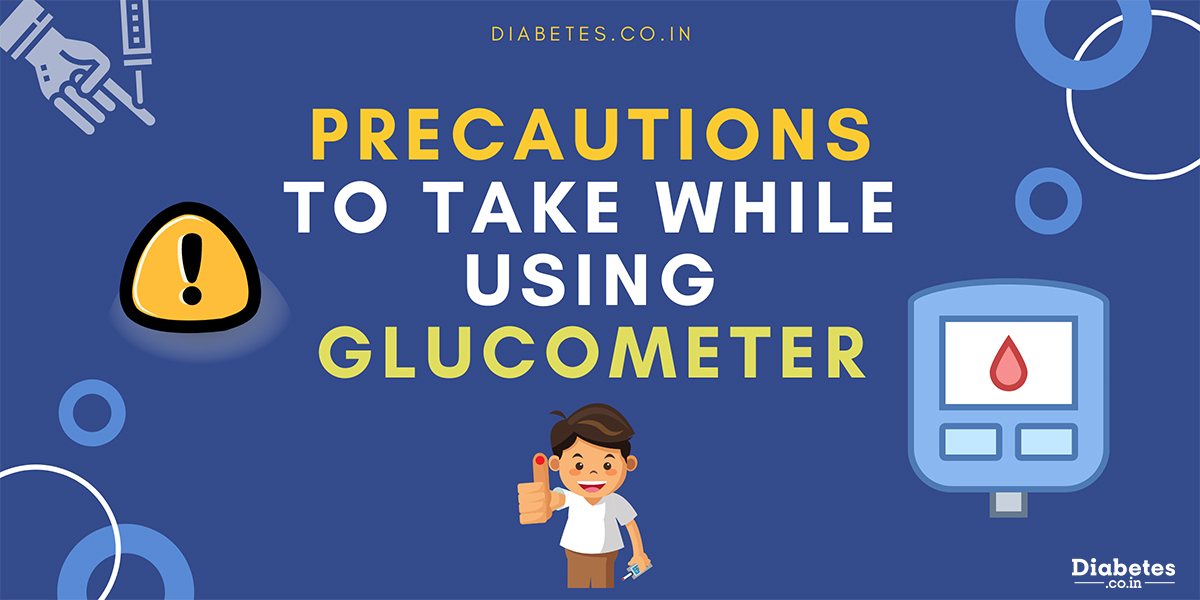What Precautions to Take While Using Glucometer?Monitoring of blood glucose using a glucometer is the cornerstone in the management of Diabetes Mellitus primarily:
- Type 1 Diabetes
- Type 2 Diabetes who are on insulin treatment
- GDM (Gestational Diabetes Mellitus).
Proper precautions should be taken when using glucometer for accurate results.

Preparing the Glucometer
- Check whether your glucometer is calibrated to report - venous plasma glucose or whole blood glucose.
- Whole blood glucose concentrations are 12–15% lower than plasma concentrations.
- Most of the currently marketed glucose meters give results as an equivalent to venous plasma glucose.
- Check your glucometer for the units of blood glucose.
- Some glucometers express blood glucose levels in SI units as milli moles/litre and some in the traditional units as milligrams/deciliter.
- Use of the wrong unit of measure may cause you to misinterpret your blood glucose level and may lead to incorrect treatment.
- To convert mmol/L glucose to mg/dL, multiply by 18.
- Some glucometers require to enter the code number to calibrate the machine before first-time use and then every time you change to another vial of test strips.
- Matching the code on the meter and the code on the test strip vial is essential to obtain accurate results.
- Some glucometers do not require coding the machine.
Storage of the Glucometer and test strips
- Store your meter, test strips in a cool, dry place below 86°F but Do Not refrigerate.
- Keep all items away from direct sunlight and heat.
- Testing must be done within the operating temperature range (43–111°F).
Preparing your sample site
- Before you test your blood glucose, wash your hands thoroughly with soap and warm water.
- It will reduce the contamination of the puncture site and increases the blood flow.
- Let the hands dry.
- Prick the side of the finger pulp; you can gently massage the finger towards the fingertip, which will help the formation of the adequate size of the blood drop.
- Choose a different puncture site each time you test.
- Repeated punctures in the same spot may cause soreness and calluses.
- You can use alternative sites for sampling, which include the base of the thumb, forearm, and thigh.
- Pre-meal blood glucose readings will be the same between these sites, but after food intake - forearm and thigh results will be different from the fingertip results.
- If you get unexpected blood glucose result, then recheck or confirm the blood glucose in the laboratory and consult your doctor for the modification of the treatment.
- Cross-check with control solution, whether your glucometer is functioning correctly.
- Never share a lancet or a lancing device with anyone.
- Always use a new, sterile lancet - lancets are for single use only.
- Keep your meter and lancing device clean.
- It is essential to discard the used lancet carefully after each use to avoid unintended lancet stick injuries.
- Used test strips and lancets may be considered bio-hazardous waste.
- Be sure to follow your healthcare professional's recommendations for proper disposal.
- Keep the meter and testing supplies away from young children.
- Small items such as the battery door, battery, test strips, lancets, protective disks on the lancets and control solution vial cap are choking hazards.